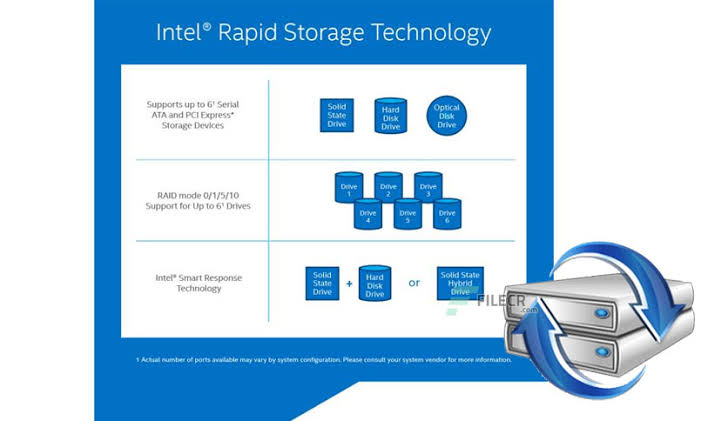
Intel Rapid Storage Technology (Intel® RST) combines hardware and software technologies that deliver optimized storage performance for Intel® Core™ processors. It includes a new generation of Serial ATA (SATA) storage devices with Transactional Synchronous Technology. This revolutionary new open-standard interface can significantly reduce Windows*’s number of data requests by Windows* to your storage subsystem. Furthermore, Intel RST features an intelligent caching system that helps accelerate application performance by preloading the physical drive with the data needed for those applications from within those applications themselves.
Intel® Rapid Storage Technology is a set of tools and technologies which help you make the most out of your PC’s storage. In Intel® Rapid Storage Technology, you get access to new levels of convenient, one-stop, software-based solutions for managing and protecting your data files—from data backups to secure data encryption. Plus, the ability to seamlessly integrate with existing systems and applications helps you manage all of your data in a unified environment with a single view towards IT efficiency.
What does Intel do?
Intel provides a range of products that improve storage performance for PC users who may want advanced solutions beyond the capabilities of traditional SATA drives. For average consumers, Intel® Rapid Storage Technology solutions include the pre-integrated ‘Intel® Rapid Storage Technology’ technology in most consumer-based PCs. More advanced users can buy separate hardware and software kits, often with all the components integrated into one enclosure or enclosure card.
Why does Intel offer these technologies?
By offering different solutions for different types of users, Intel helps optimize performance and compatibility for most consumers. Moreover, users get even greater value from their new performance-enhanced systems by providing an integrated solution with other software applications.
What is the difference between hardware and software technologies?
Intel offers two types of solutions: hardware and software. Hardware solutions consist of an enclosure with a PCIe card that contains the silicon components needed to accelerate storage performance and other application-specific features such as security software. Intel® Rapid Storage Technology software, on the other hand, consists of a package for Windows* OS that contains the code needed to communicate with either a separate PCIe card or a SATA storage device.
What is new about Intel® Rapid Storage Technology?
Intel® Rapid Storage Technology is a new generation of Transactional Synchronous technology from Intel that provides users with new levels of system performance and data protection. Intel® Rapid Storage Technology combines the benefits of Serial ATA with the performance of Data Center SSDs and offers a new level of convenience for end-users.
What is the difference between Intel® Rapid Storage Technology and SATA?
Intel® Rapid Storage Technology uses a new interface called Transactional Synchronous Serial ATA (TS SATA) to perform faster, more reliable transactions with higher throughput. With this technology, devices can quickly recover from errors and access data quicker than traditional Parallel ATA (PATA) drives. Intel® Rapid Storage Technology also improves reliability by using a combination of hardware and software algorithms to tune hard drive parameters over time without user intervention automatically. Also, with Intel® Rapid Storage Technology, users can protect their data more efficiently and with less work than before by using the security and encryption capabilities built into the solution.
Why is Transactional Synchronous Serial ATA (TS SATA) technology better than Parallel ATA (PATA)?
Transactional Synchronous Serial ATA (TS SATA) technology is a new interface that can significantly improve Parallel ATA (PATA). With TS SATA, user data transfers up to 10 times faster than with PATA drives. In addition, TS SATA supports RAID Level 0 and 1, whereas PATA does not support any form of fault tolerance.
What is the performance advantage of Intel®’s Rapid Storage Technology solutions over traditional hard drives?
With Intel® Rapid Storage Technology, users can expect an average increase in performance of up to 30% depending on the level of acceleration hardware and software. For example, standalone 2nd generation Intel® Core™ i7-based platforms with the Intel® X79 chipset and the Intel® Serial IO controller experience increases in performance between 14-30% when using 2nd generation Intel® Core™ i7 processor-based systems with directly attached storage devices that leverage pre-integrated hardware and software components.
How does Intel® Rapid Storage Technology accelerate application performance?
Intel® Rapid Storage Technology provides a smart caching system that can preload the data needed by an application before it is required. This speeds up application boot times and reduces waiting for applications since the data is already in the drive. It allows users to work with their applications more quickly since the data they need has been copied into the faster SSD part of the storage device.
Which Intel® processors support Intel® Rapid Storage Technology?
Intel® Rapid Storage Technology works with all sixth-generation Intel® Core™ processors and selected third-generation Intel® Core™ processors. Note, the products below are the latest supported CPUs; older processors will not be fully supported.
Intel® Core™ i7-3520M Processor (3rd Gen Intel® Core™ i7)
Intel® Core™ i5-3210M Processor (3rd Gen Intel® Core™ i5)
Intel® Core™ i5-3360M Processor (3rd Gen Intel® Core™ i5)
Intel® Pentium® G6950 Processor (3rd Gen Intel® Pentium)
How do users install or uninstall Intel® Rapid Storage Technology?
To use or uninstall the software, follow the instructions in the user’s manual. For both options, users can choose which drive they want to use with the solution.
What are the hardware requirements for Intel® Rapid Storage Technology?
Intel® Rapid Storage Technology requires an Intel® chipset with an integrated Serial IO controller, a second-generation Intel® Core™ processor, and a storage device with a compatible interface. The enclosure or enclosure card also must support two or four lanes of PCIe* Gen 2.0 bandwidth to expose the optimized performance capabilities of the technology entirely.
How much is hard drive space required for a software solution?
Users need to have the following hard drive space available to support Intel® Rapid Storage Technology: 1GB if using a pre-integrated solution that includes security software, and 2GB if using a standalone software kit that does not include security.






